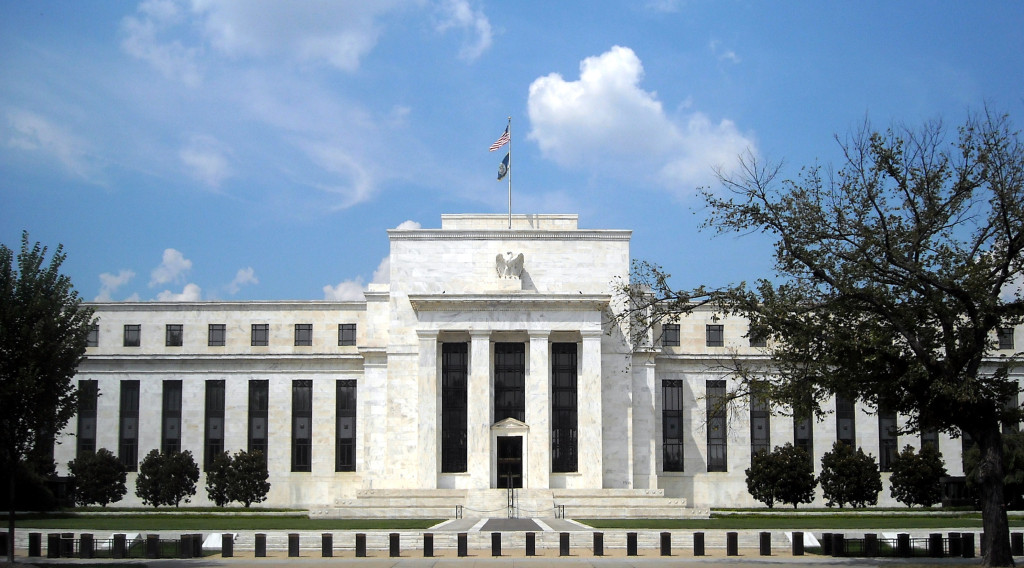Global Data: A New Scapegoat for the Federal Reserve
This article was written by Nelson Gilliat, a millennial supporter of sound money and Austrian economics. Any views expressed are his own and do not necessarily reflect the views of Peter Schiff or SchiffGold.
During March 16th’s FOMC meeting, the Fed announced that it would leave interest rates unchanged and scaled back its December projections for higher rates in 2016, 2017, and 2018. The Fed’s backtracking comes just three months after raising interest rates 25 basis points, its first hike since June 2006.

While the Fed’s backtracking on higher interest rate projections was the big news of the meeting, another emerging trend also deserves attention – – the Fed’s backtracking from being US data dependent and toward being global data dependent.
Global factors are playing an increasingly larger role in the Fed’s decision to raise interest rates.
According to last week’s FOMC statement, “economic activity has been expanding at a moderate pace despite the global economic and financial developments of recent months” and warned that “global economic and financial developments continue to pose risks.”
In fact, the Fed’s concern over global factors’ influence on our sluggish economy leads it to directly list global factors as one of its criteria for raising interest rates:
In determining the timing and size of future adjustments to the target range for the federal funds rate, the Committee will assess realized and expected economic conditions relative to its objectives of maximum employment and 2 percent inflation. This assessment will take into account a wide range of information, including measures of labor market conditions, indicators of inflation pressures and inflation expectations, and readings on financial and international developments.”
Now, when deciding to raise rates, the Fed will not only consider US data such as inflation, employment, and financials, but also global data, such as “readings on international developments.” The Fed’s interest rate policy is now directly linked to global factors, a departure from previous Fed policy that was solely dependent on US data.
There are two likely reasons for the shift to global data. First, the addition of global factors gives the Fed another excuse not to raise rates. If the Fed were to follow US data alone, then it would be pressured to raise rates: unemployment is at 4.9%, 242,000 jobs were added in February, and inflation is picking up steam with core CPI at 2.3%.
As Michael Feroli, chief U.S. economist at JPMorgan Chase, states:
The current uncertainty over the global outlook and what it means for the U.S. economy is not easily susceptible to measurement. We think this language buys them time.”
Since neither the content nor the measurement of global factors was specified, this ambiguity gives the Fed leeway to claim anything — oil prices, downturns in China, Europe, etc. as pretenses for delaying, or even lowering interest rates.
The second reason for the shift to global data is that it provides the Fed with a scapegoat. Regardless of whether the Fed raises, lowers, or leaves interest rates unchanged, it can blame any bad outcomes on external factors outside of its control. Just look at what happened in December when the Fed’s 25 basis point rate hike and promise of future ones sent stocks tumbling. China and low oil prices, not the Fed, took the blame.
What does the Fed’s apparent uncertainty regarding the direction of higher interest rates mean for gold? Interest rate increases represent a return to economic normality and certainty. Conversely, periods of economic abnormality and uncertainty augur well for gold.
Get Peter Schiff’s most important Gold headlines once per week – click here – for a free subscription to his exclusive weekly email updates.
Interested in learning more about physical gold and silver?
Call 1-888-GOLD-160 and speak with a Precious Metals Specialist today!




 As fiscal imbalances persist, driven by coercive measures and artificial currency creation, the middle class faces erosion and purchasing power dwindles. But as the world hurtles towards a potential reckoning, the lingering question remains: can this precarious balance last, or are we teetering on the brink of a cataclysmic economic shift?
As fiscal imbalances persist, driven by coercive measures and artificial currency creation, the middle class faces erosion and purchasing power dwindles. But as the world hurtles towards a potential reckoning, the lingering question remains: can this precarious balance last, or are we teetering on the brink of a cataclysmic economic shift? Beneath the veneer of headline job gains, the American economy teeters on the brink: native employment dwindles as part-time and immigrant jobs surge. Government hiring camouflages looming recession warnings. Inflation and political blunders worsen the crisis, fueling public outrage at the establishment’s mishandling of the economy.
Beneath the veneer of headline job gains, the American economy teeters on the brink: native employment dwindles as part-time and immigrant jobs surge. Government hiring camouflages looming recession warnings. Inflation and political blunders worsen the crisis, fueling public outrage at the establishment’s mishandling of the economy. On April 5 1933, Franklin D. Roosevelt abandoned the gold standard, wielding questionable legal power amidst America’s dire economic depression. His whimsical approach to monetary policy, including coin flips and lucky numbers, unleashed unprecedented inflation and price increases that have since amounted to nearly 2500%. Our guest commentator explores this tragic history and the legacy […]
On April 5 1933, Franklin D. Roosevelt abandoned the gold standard, wielding questionable legal power amidst America’s dire economic depression. His whimsical approach to monetary policy, including coin flips and lucky numbers, unleashed unprecedented inflation and price increases that have since amounted to nearly 2500%. Our guest commentator explores this tragic history and the legacy […] Welcome to the world of modern economics where the term “inflation” no longer signifies the increase in the quantity of money, but has evolved into a plethora of buzzwords. From “shrinkflation” to “greedflation,” these new terms and semantic shifts are by no means harmless but a manipulation of popular sentiment. Von Mises said they play […]
Welcome to the world of modern economics where the term “inflation” no longer signifies the increase in the quantity of money, but has evolved into a plethora of buzzwords. From “shrinkflation” to “greedflation,” these new terms and semantic shifts are by no means harmless but a manipulation of popular sentiment. Von Mises said they play […] Assuming CPI measurements are not understatements, the dollar’s value has plummeted by a staggering one-fifth since 2020, yet, rather than acknowledging its role in fueling this economic turmoil, the Biden administration deflects, casting capitalism and corporate greed as the villains. The latest February CPI data show more signs of the upcoming inflation bloodbath.
Assuming CPI measurements are not understatements, the dollar’s value has plummeted by a staggering one-fifth since 2020, yet, rather than acknowledging its role in fueling this economic turmoil, the Biden administration deflects, casting capitalism and corporate greed as the villains. The latest February CPI data show more signs of the upcoming inflation bloodbath.
Why does the Federal Reserve target a 2% inflation rate. Isn’t their main goal (among the ones added later) supposed to be to stabilize the value of the currency? My suspicion is that the 2% inflation goal is a decoy as an excuse to keep interest rates low for some other purpose, such as an excuse to keep interest rates low to slow the increase of the cost of servicing the government’s massive debt to postpone the default that must come sooner or later. They are just trying to make it later – and on someone else’s watch. Confirm? Deny? Elaborate?